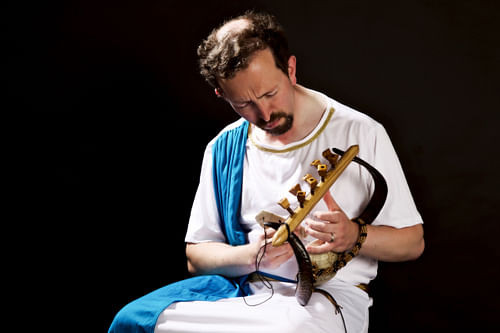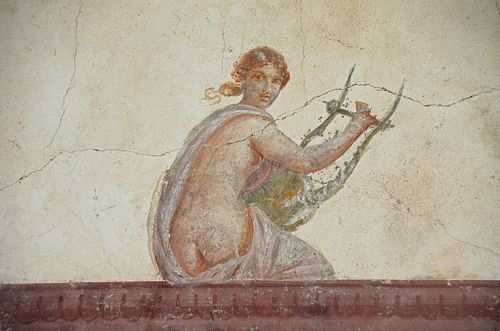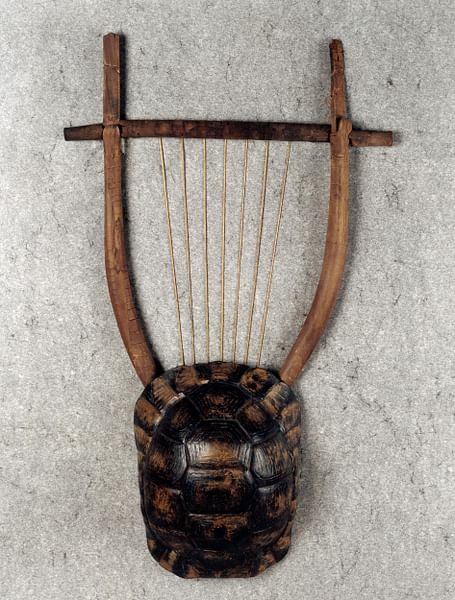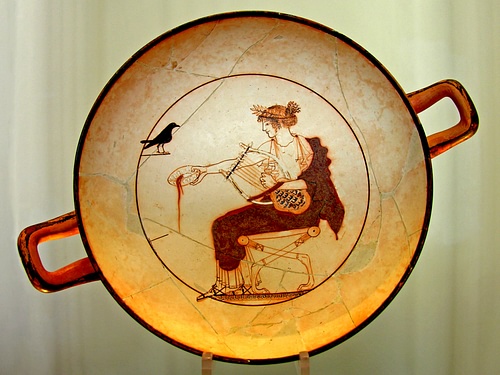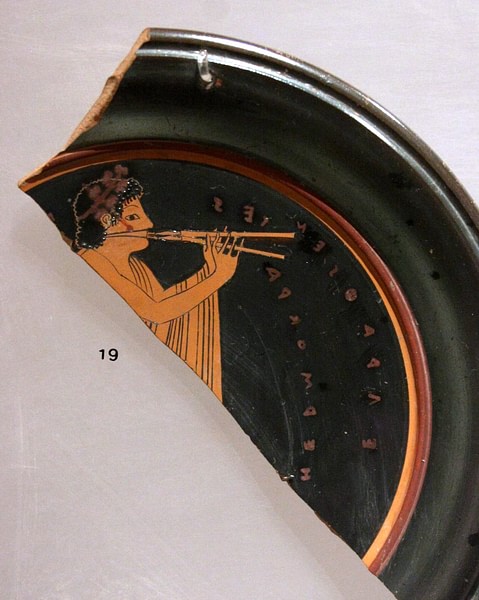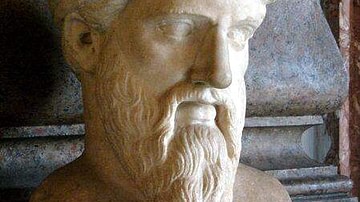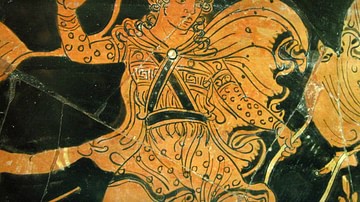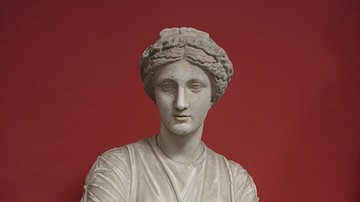Join World History Encyclopedia as they talk to Michael Levy, a prolific composer of the ancient lyre all about his inspiration and knowledge of the instrument. If you want to hear Michael perform, be sure to check out our video interview below.
Kelly (WHE): Let us start with the inspiration behind your musical quest. Why the lyre? Why did you start playing the lyre?
Michael Levy: Why not? Date back my interest in all things ancient and mysterious when I was 14 years old, I just happened to find a cassette tape back in those days of the late great David Monroe, who was the first person to really get into recreating music from the Middle Ages and the Renaissance. The most fascinating thing about this music is the transporting quality I found. I have never heard this in any other type of music. I have been to museums in the past, but as soon as I heard his music from the time of the Crusades, I felt I was in some medieval castle.
This is the immersive quality that music has, and that is what first got me into ancient type music. As for the actual lyre, when I was 14, I happened to hear this LP by the classical guitarist John Williams and Julian Bream called Together, and it was a magnificent arrangement of Ravel's Pavane for A Dead Princess. There were all these modal sections, and it sounded like a lyre. Then it took about 25 years later until about 2006; I was just randomly looking for some interesting CDs on Amazon, and I found something called Music from the Time of Jesus and Jerusalem's Second Temple. In the notes, I found that the modern avocation of the lyre that was used in the recording was played by the Levites, who could be my very own ancient Levite ancestors.
I got my first lyre on eBay, and that is what I taught myself on and put a few things on YouTube back in the early days of 2006. YouTube was very new then and just kind of progressed from there. The great thing about YouTube is you get lots of constructive as well as destructive feedback, and I just worked my way up through different types of lyres. I got a more expensive one in 2011, thanks to someone's recommendation. Then, randomly, in 2014, I got an email from Luthieros in Thessaloniki in Greece, and they are doing the same thing as me but in Greece. They are recreating ancient Greek lyres for enthusiastic experimental modern musicians like myself. Thanks to my collaboration with Luthieros, I have acquired a kithara and tortoiseshell lyres – actual tortoiseshells foraged from the forest of Thessaloniki with some nice goat's horn.
Kelly: That is amazing because that just makes me think of the mythological beginnings of the lyre, where baby Hermes on his first day of life invents the lyre out of a tortoiseshell.
Michael: Yes. That has been the inspiration for my latest album. It is called The Cave of Hermes, and it is just like imagining the first tunes Hermes might have played in his cave.
Kelly: Amazing. So, you have multiple different lyres?
Michael: Yes. I have a kithara – where we get our modern name for guitar – with a very deep, almost guitar-like sound as well as lyres with tortoiseshell resonators.
Kelly: They are all obviously different sizes and shapes. Do they all need different playing techniques?
Michael: Yes. The playing techniques are a mixture of what I can infer from ancient pictures of lyre players. When you see a lyre player in ancient Greek pottery and paintings, you have always got the left hand blocking specific strings, and one of these nice little chunky plectrums doing things. It is not like a harp, where you block strings to stop unwanted sustain. You are blocking strings that you do not need to play, and you are keeping open the strings you do want to play so you can create chords. That is inferred from ancient Greek illustrations on pottery, and in parts of Africa, the lyre is still played today; the Krar in Eritrea, this block and strum technique is alive and well in Eritrea. In Egypt, they play the Simsimiyya, this wonderful tremolo sound. So that is where I get my tremolos from, a bit like a mandolin. Playing the lyre is like playing the harp, guitar, and mandolin all in one instrument. It is like literally a portable orchestra.
Kelly: Amazing!
Michael: The kithara though, has got a deeper tone to it. In ancient Greek music, only the professionals played the kithara, whereas the chelys (Greek for the tortoiseshell lyre), was for domestic use, for example at a symposium, an ancient Greek drinking party. Plato, in the Republic, advocates teaching young boys musical theories on the lyre because its notes are clear and pure.
The construction of the kithara is interesting. Some scholars think they were used as a vibrato mechanism. The way Luthieros constructed it, they have a movable corssbar (yoke), and by applying pressure to the it, one can create portamento and vibrato sounds. But it [the vibrato mechanism] is only hypothetical because there are no surviving examples of an original ancient Greek kithara to verify with certaintly, the possibility of a vibrato mechanism. However, as a strong argument against this hypothesis, in the Parthenon frieze, there is actually a three-dimensional surviving fragment of a sculpture of this specific part of the kithara, depicting the junction between the arms and the crossbar. This sculpture clearly shows that the arms of the kithara encased the crossbar, so that would render any sort of vibrato mechanism impossible. It is more likely that this construction is a suspension bridge. It provides equal and opposite reaction to the downward pull of the strings. That is what most scholars tend to think, but it sounds great with a vibrato mechanism. So, if we can improve on what the ancient Greeks were doing, so be it. That is what I want to do. I want to carry this sort of new ancestral music. I call it new compositions for recreated ancient lyres into the 21st century and beyond.
Kelly: Everything that you know about the lyre, is that all from surviving images?
Michael: Yes. There are a few tortoiseshell lyres that survived, like the Elgin Lyre in the British Museum, I had the pleasure of seeing that a few years ago. Also, there are ancient Egyptian lyres that have survived. I got from Luthieros, a replica of the Leiden Lyre, which is preserved in Leiden and that dates to about 1500 BCE. It is an amazing thing. As far as ancient Greek lyres go, only the tortoiseshell lyres seem to have survived, the chelys lyres, as they called them. There are sadly, no surviving examples of the kithara, because it must have been very lightly constructed out of wood. Wood is more perishable than tortoiseshell.
Kelly: At least you have got the tortoiseshell. Obviously from the images that are surviving, you have been able to see how they would play them.
Michael: The great thing about tortoiseshell lyres is that because no tortoiseshells are the same, every lyre sounds different.
Kelly: If they all sound different, how do you go about learning to play the lyre?
Michael: That is the beauty of it. This ties into what Plato says in the Republic about society being like a well-tuned lyre. Every individual is different, just like all the different lyres, different lyre strings, that when put together form a harmonious union. The challenge is to take the actual recreated instrument and jam on it until you get something that sounds good. That is the great thing about it.
Compared to, say, a harp, on the ancient Greek lyres, the bass strings are closest to the player instead of further away. The reason for that is quite simple; if the bass strings are closest to you, you can feel the resonance of the instrument better. The defining feature of a lyre is the little bridge over which the strings pass, just like a guitar. The kithara is like a guitar without a fingerboard.
Kelly: Do you want to tell us a little bit about the ancient tuning methods, what that means and why that is important?
Michael: There are two components to the ancient tuning methods. First, we have what we call the intonation. That is the specific ratio of how the musical intervals are formed. The other aspect is these wonderful ancient modes that we have almost forgotten about in our modern, very standardised Western music, where all we have are major and minor keys. The ancient Greek modes, for example, have all different qualities.
In antiquity, they used just intonation. The basic concept started way back in ancient Mesopotamia when they were creating the first fretted lutes. They experimented, working out where they could put the frets on these lutes, but it was not until the time of Pythagoras that experiments on a monochord, which is one string with different bridges on the string, led to the discovery of the specific ratios that form these beautifully pure musical intervals. They are much purer than the music we are accustomed to in modern, equal temperament because they use whole-number ratio.
Let us starts off with the Pythagorean fourth. The ratio that Pythagoras discovered was the ratio 4:3. If you have a string and you divide it three-quarters of the way through, it is going to be a nice, pure sound. Then, if you divide the string into two-thirds, that gives you the ratio 3:2, and that is the perfect fifth. Then, if you divide the string in half, that is the ratio 2:1, and that gives you what we call the octave. These are the three basic intervals in just intonation that you get in Pythagoras. Why is the reason he only uses these three intervals? All because of some other very quirky thing, which is his numerical cosmology. These ratios that are described 4:3, 3:2, 2:1, they all fit into a tetractys for the Pythagoreans. This was a sacred symbol, almost like a mathematical religion, they thought that the tetractys was how space itself was organised. It also symbolised the four elements of fire, water, earth, and air.
This is where the music bits come in because the ratios that Pythagoras discovered can all be fit into this tetractys. He was well into the mysteriousness about it, but that didn't really take into account musicality, because then you have an interval, the third. A few hundred years later, Ptolemy, a Greco-Roman musical theorist, approached music in a different way. He was concerned with musical sounds being consonant and nice and harmonious, and he sought a scientific rationale to explain why this might be. He listened to how musicians tune by ear and then worked out the maths from that. Then we came up with the third, the pure third, and that is the ratio of 5:4.
Now, on to the modes! Our bland major and minor keys that we have in Western music these days are great for symphonies and things where you can transpose the different keys and maintain the same ratio between them because every ratio is artificially made equal, it makes it slightly out of tune, but it gave us the works of Mozart and Beethoven. However, equal temperament and the major minor keys can be quite boring, and a whole world of musical expression is being lost. Indeed, in the Republic, Plato described some of the modes, and the one he liked most of all sounds a little bit like a minor key, but not it is not just minor, it has this intensity to it, and, according to him, it inspired bravery in battle. This was the ancient Greek Dorian mode. Now this is where it gets even more confusing because in the early Middle Ages, scholars gave the original Greek modes the wrong Greek names.
There is nothing primitive about ancient music because nothing has changed in the way our brains structure the world, and we are only about 20-odd generations away from 2000 years ago. And yet, the Greeks were precise with their music theory; special number ratios give you these geometrically pure musical intervals. When you are using such pure intervals, you do not need all this excess harmony. That is why I love lyres; for ages, I have been trying to find a way of playing minimalistic music where you do not need any fancy stuff. That is the beautiful thing when you start using these pure intonations, you do not need anything more complicated. A perfect fifth in just intonation perfectly frames the melody, and it frees up your creativity to do whatever you want with the melody line. So that is why I use these wonderful modes and intonations.
Kelly: Is the lyre meant to be played with other instruments, or is it a solitary instrument?
Michael: In the fragments of pottery, it was usually accompanied by the aulos, which is a two-reed pipe played simultaneously by the same performer. It is still taught in schools that harmony was somehow mystically invented in the Middle Ages, but it was not! The whole thing is a problem, a basic logical error, confusing the first codification of harmony back in the early Middle Ages with the first creation of harmony, which goes back to as long as humans have been singing because every human singer has voices at different pitches.
Take the Aka Pygmies in Central Africa for example. They have had no influence at all from the Western world, and they sing in beautiful polyphony. Ancient texts mentioned the use of harmony; Plato described how you best should teach young boys the theory of music. As well as saying they should use the notes of the lyre because they're pure and sweet, he also tells teachers that they should avoid using complex performance practices of the day, for example, playing the long note with the short that is two notes and two tunes together. All the things that we do today, the ancients were doing it quite happily. The only thing you cannot do in just intonation is transpose to different keys.
Kelly: But other than that, they are still instruments that were created to play with other instruments.
Michael: Yes, of course. The aulos, by definition, plays two notes at the same time, and you can play counterpoints in it. There is the aulos preserved in the Louvre, and there is Barnaby Brown who specialises in playing the aulos. You can find him on YouTube. It is amazing. It sounds like playing two instruments at the same time.
Kelly: Do you want to tell us a bit about your track Hymn to the Stars? The inspiration for it, the creation of it, and what lyre you played?
Michael: I used my kithara to play this. I am not a trained singer, I have got this kind of baritone register, which is quite annoying because it is very limited. I cannot sing very high, and I cannot sing very low. I have only got an octave to work with. It is just a very simple vocal line, and the whole thing is back in the day in ancient Greece, where the kithara was used for recitations of epic poetry. For example, the Iliad was meant to be performed with musical accompaniments and has all these detailed rhythmic meters and things that you can only remember if you are reciting it to a tune.
The same thing with the sixth Orphic Hymn to the Stars, to Astron. I am really into astronomy as well as music; I am a bit of a geek in that way. I thought this should be a really cool thing to do and it is very inspirational. It is very dramatic, and you can just imagine some ancient Greek person looking up at what they thought were these rotating celestial spheres. And again, that ties into musical intervals as well. They thought that all the stars were on this massive sphere because they moved together across the sky. This movement itself caused a sound that no one else could hear, though they thought Pythagoras might be able to hear it because he managed to deduce the ratios of these musical intervals I mentioned before.

For the Sixth Orphic Hymn, I had to go do something really dramatic, and the musical modes are just beautiful. This is in the ancient Greek, what we call the Phrygian mode, but not to be confused with the medieval Phrygian mode, because in the Middle Ages, the medieval scholars gave all the original Greek modes the wrong Greek names, which is very confusing. So basically, the original ancient Greek Phrygian mode is the equivalent intervals D to D on the white notes of the piano.
The ancient Greeks did not call them modes, and they comprise of the conjunction of two tetrachords which form these things. The Greeks were intricate in their musical theory. There is nothing simple or primitive about ancient Greek music. It was really advanced, and that is why I hearken back to what has been forgotten in Western music. The beautiful sounds of the modes, just intonation, and carrying this forward into my own music, into the 21st century to find this spiritual point in music that has been forgotten in our sadly commercialised nightmare of contemporary pop music. I just want to do something completely new and create new music for ancient lyre, to create this new meditative sound.
Kelly: Do you have a favourite song that you have composed yourself?
Michael: A couple, actually! But one that was what I called Hymn to Zeus. It is in a dream scene and all you have are these beautiful, pure intervals of fifths and fourths. That is all it is.
Kelly: It is absolutely beautiful. Thank you so much, Michael, for joining me!
Michael: It was a pleasure. Thank you, Kelly.
